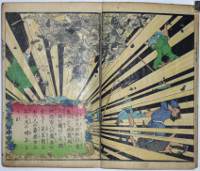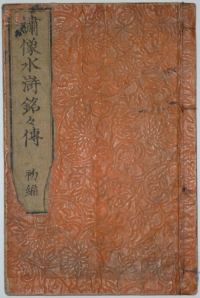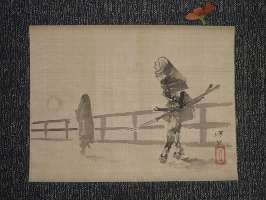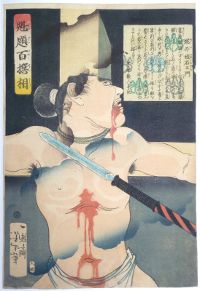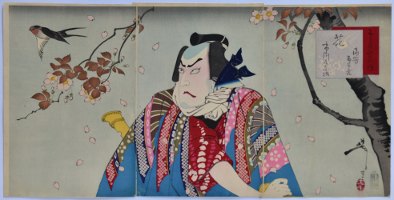Tsukioka YOSHITOSHI (1839-1892)

Click here to view image full size.
Saito no Oniwakamuru from the set Ikkai zuihitsu, “A Miscellany by Ikkai.” (This being an early name of Yoshitoshi’s.) The young Saito Musashibo Benkei was given the moniker Oniwakamuru “Devil Child” because of his feats of strength and general behaviour. The episode depicted here, which was a popular theme for artists, shows the young Oniwakamaru battling a giant carp at the Bishamon Waterfall, where he has gone looking for his mother, Ohaya. On killing the carp, he discovers it has eaten his mother. A set published by Masadaya Heikichi, 1872-3 (this being 1872). Even amongst Yoshitoshi’s best work, this is an outstanding design.
Very fine impression of the first edition. Fine colour and condition. Signed Ikkaisai Yoshitoshi hitsu.
Status: Sold
Tsukioka YOSHITOSHI (1839-1892)

Click here to view image full size.
Shows the famous Heron Maiden. There are different versions of this story but the most common tells how a young man finds an injured heron. He nurses it back to health and releases it. Some time later a beautiful young woman appears in his village. He falls in love and they marry. She makes fine brocade which they sell, but she does not allow him to see her making it. Tempted , he secretly views her only to discover she is the heron. This is the end of their marriage and the heron flies away. From the set Shingata sanjurokkaisen, “New Forms of Thirty-six Ghosts,” subtitle: Sagi-musume. The set published by Sasaki between 1889-1892 (this being 1889). This is the first edition.
Very fine impression, colour and condition. Signed Yoshitoshi.
Status: Sold
Tsukioka YOSHITOSHI (1839-1892)

Click here to view image full size.
Musashino no tsuki, “The Moon on Musashi Plain” from the set Tsuki hyakushi, the “Hundred Phases of the Moon.” The set published between 1885 and 1892 (this being 1892) by Akiyama Buemon. One of the three best designs from the set and one that relies most on the printer’s art – using extensive bokashi. The fox was capable of transmogrifying into human form and vice versa and was popular in Japanese folklore.
Very fine impression with beautiful gradation of the earliest printings on the grasses around the fox. (See Beauty & Violence, 1992, 54.97, p. 75 for an example of the more prosaic later printing.) The set was popular and many editions were printed and many late impressions exist. Great care was taken with the cutting of the blocks on this set and only early impressions do them justice. Fine colour and condition. An impression that has not been in an album. Full margins. Signed Yoshitoshi.
Status: Sold
Tsukioka YOSHITOSHI (1839-1892)

Click here to view image full size.
A fox priest from the set Tsuki hyakushi, the “Hundred Phases of the Moon.” The set published between 1885 and 1892 (this being 1886) by Akiyama Buemon. Based on the Kyogen farce Konkai, “A Foxe’s Cry” which tells of a hunter who is lectured on trapping foxes by his uncle, a priest. On his way home his uncle turns into his true form, a fox, and is snared in a trap. Yoshitoshi’s design shows the uncle transmogrifying into a fox. One of the best designs from the set.
Fine impression and colour from an early printing. The set was popular and many editions were printed and many late impressions exist. Great care was taken with the cutting of the blocks on this set and only early impressions do them justice. Fine colour and condition. An impression that has not been in an album. Full margins. Signed Yoshitoshi.
Status: Sold
Tsukioka YOSHITOSHI (1839-1892)

Click here to view image full size.
A triptych Gikeiki Gojobashi no zu, “Gojo Bridge in the Chronicles of Yoshitsune.” Shows Musashi-bo Benkei of herculean strength subdued by the young Onzoshi Ushiwaka Maru (Yoshitsune) on Gojo Bridge.The story relates how Benkei (1155-1189) wandered around Kyoto with the intention of relieving 1000 samurai of their swords. One night, with one more sword to go, he saw Yoshitsune playing a flute and wearing a golden sword at the Gojotenjin Shrine. They agreed to fight on Gojo Bridge in southern Kyoto. However, Yoshitsune was too agile for Benkei and had been educated in the secrets of fighting by the tengu. Following Yoshitsune’s victory Benkei became Yoshitsune’s retainer. Published by Morimoto Junzaburo, 1881. One of Yoshitoshi’s best designs.
Very good impression and colour. Later editions lack the black outline around the moon and have clouds added. (Interestingly, a feature usually found on the earliest states of prints, but in this case the reverse.) Very good condition. Signed Taiso Yoshitoshi ga.
Status: Sold
Tsukioka YOSHITOSHI (1839-1892)

Click here to view image full size.
A triptych showing the Japanese Buddhist deity Fudo Myo-o, one of the five “Kings of Wisdom,” above the novitiate priest Yuten Shonin (1637-1718) about to consume the sword of wisdom thereby gaining supernatural wisdom and enlightenment. (Often miscatalogued as threatening him.) On the right is the goddess of mercy, Kannon. The scene is set in the Zojoji Temple where Shonin goes on to become the Abbot. Published by Akiyama Buemon, 1885.
Fine impression with the publisher’s details intact in the left border of last sheet – often trimmed off. Fine colour and condition. Signed Yoshitoshi.
Status: Sold
Tsukioka YOSHITOSHI (1839-1892)

Click here to view image full size.
A vertical diptych Shunkan sozu Kikaigashima ni oite tamatama Yasuyori no shamen sembo kito no zu. Shows Shunkan watching a boat sail away from Kikai Island with his pardoned compatriots. Shunkan, the abbot of the Zen temple Hoshoji in Kyoto, was exiled to the barren island of Kikaigashima together with two confederates in 1177 for conspiring against Taira no Kiyomori. The following year Kiyomori pardons political prisoners but omits Shunkan. He is seen here beseeching the boat with his two conspirators to return. Published by Matsui 1886.
Fine impression of first state. Fine colour with splashed gofun and blind-printing. Fine condition with ample room for joining the two sheets. Signed Yoshitoshi.
Status: Sold
Tsukioka YOSHITOSHI (1839-1892)

Click here to view image full size.
Shows Asahina Saburo Yoshihide, the fabled warrior of superhuman strength, subjugating the King of Hell, Ema-o. He forces him to indicate the path to Heaven. This episode is from the kabuki play Asahina. From the set Ikkai zuihitsu, “Essays by Yoshitoshi.” (Ikkai was an early name of Yoshitoshi’s.) A set of thirteen prints published by Masadaya Heikichi 1872/3. A fine set.
Extremely fine impression and colour from the first edition. Most designs from the set have red seals in the margin and red seals over the signature. These were removed on later editions. Margins trimmed a little, otherwise fine condition. Signed Ikkaisai Yoshitoshi hitsu.
Status: Sold
Tsukioka YOSHITOSHI (1839-1892)

Click here to view image full size.
Shows the famous episode from the Edo novel Nanso Satomi hakkenden “Chronicles of the Eight Dog Heroes of the Satomi Clan of Nanso.” Two of the heroes Inuzuka Shino and Inukai Kempachi fall from the rooftop of Horyukachu Tower, Koga Castle, still grappling with each other and scattering pigeons as they descend into the Tone River. From the set Ikkai zuihitsu, “Essays by Yoshitoshi.” (Ikkai was an early name of Yoshitoshi’s.) A set of thirteen prints published by Masadaya Heikichi 1872/3. A fine set.
Extremely fine impression and colour from the first edition. Most designs from the set have red seals in the margin and red seals over the signature. These were removed on later editions. Margins trimmed a little, otherwise fine condition. Signed Ikkaisai Yoshitoshi hitsu.
Status: Sold
Tsukioka YOSHITOSHI (1839-1892)
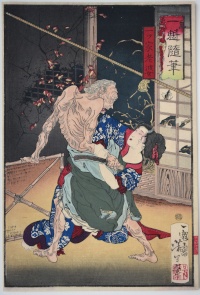
Click here to view image full size.
Shows the cannibalistic old hag of Adachi Moor attacking a young woman. There are various versions of this macabre story but the central theme is that she needed to collect blood, usually from unborn children, either for herself or as a remedy for her sickly lord. From the set Ikkai zuihitsu, “Essays by Yoshitoshi.” (Ikkai was an early name of Yoshitoshi’s.) A set of thirteen prints published by Masadaya Heikichi 1872/3. A fine set.
Extremely fine impression and colour from the first edition. Most designs from the set have red seals in the margin and red seals over the signature. These were removed on later editions. Margins trimmed a little, otherwise fine condition. Signed Ikkaisai Yoshitoshi hitsu.
Status: Sold
Tsukioka YOSHITOSHI (1839-1892)

Click here to view image full size.
Yodo-no-Kimi (aka Yodogimi), the concubine and second wife of the daimyo Toyotomi Hideyoshi, readies herself for seppuku: Hideyoshi, having died, she and her son are thought to pose a threat to Tokugawa Ieyasu who had become a guardian of Hideyoshi’s son. They hold up in Osaka castle where they commit suicide, rather than be captured. From the set Ikkai zuihitsu, “Essays by Yoshitoshi.” (Ikkai was an early name of Yoshitoshi’s.) A set of thirteen prints published by Masadaya Heikichi 1872/3. A fine set.
Extremely fine impression and colour from the first edition. Most designs from the set have red seals in the margin and red seals over the signature. These were removed on later editions. Margins trimmed a little, otherwise fine condition. Signed Ikkaisai Yoshitoshi hitsu. d on later editions. Trimmed on black border at left, otherwise fine condition. Signed Ikkaisai Yoshitoshi hitsu.
Status: Sold
Tsukioka YOSHITOSHI (1839-1892)
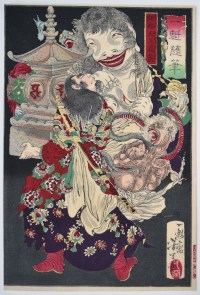
Click here to view image full size.
Shows Chao Gai (Jap. Takuto Tenno Chogai), the Heavenly King and Suikoden hero, lifting a stone pagoda which releases a Pandora’s box of gruesome spirits: An enormous white figure with a face on its abdomen, various oni and a brown spirit, its chest holding a twisting snake. From the set Ikkai zuihitsu, “Essays by Yoshitoshi.” (Ikkai was an early name of Yoshitoshi’s.) A set of thirteen prints published by Masadaya Heikichi 1872/3. A fine set.
Extremely fine impression and colour from the first edition. Most designs from the set have red seals in the margin and red seals over the signature. These were removed on later editions. Trimmed on black border at left, otherwise fine condition. Signed Ikkaisai Yoshitoshi hitsu.
Status: Sold
Tsukioka YOSHITOSHI (1839-1892)

Click here to view image full size.
“Flood” from a series Seiu kandankei, “A Barometer of Emotions.” Shows Nakamura Shikan III as Abe Bungo no Kami riding his horse through waves. Published by Okura Magobei 1876-77 (this being 1876). A rare set with some striking designs comparing actors in theatrical roles with meteorological phenomena.
Fine impression and colour. Slight trimming, otherwise fine condition. Signed Oju Yoshitoshi hitsu.
Status: Sold
Tsukioka YOSHITOSHI (1839-1892)
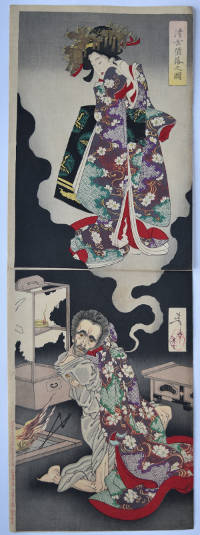
Click here to view image full size.
A vertical diptych Seigen daraku no zu showing the priest Seigen of the Kiyomizudera Temple in Kyoto and the beautiful Sakura-hime (Princess Sakura). Several versions of the story exist. In one, Sakura-hime is Seigen’s long-deceased lover reincarnated as a young priest called Shiragiku. In another, Shiragiku is the dead lover reborn as Sakura-hime. The main thrust of the tale is that Seigen’s lust gets the better of him resulting in his removal from the temple. It was the basis of the play Sakura Hime azuma bunsho premiered 3/1817. This is the rare first state of the first edition published by Matsui Eikichi, 1889. It was republished by Hasegawa Tsunejiro in 1889 with the publisher and date in left border and on most impressions a seal at top left reading “Reproduction not allowed.”
Very fine impression with hand-applied colour to the eyes, teeth and nails with gum overlay to eyes on Seigen. Fine colour. Minor edge wear to right, otherwise fine condition. Ample room for joining. Signed Yoshitoshi.
Status: Sold
Tsukioka YOSHITOSHI (1839-1892)

Click here to view image full size.
A heavily tattooed fishmonger, Danshichi Kurobei, slaughtering his father-in-law, Mikawaya Giheiji, in a swamp. From a set Eimei nijuhasshuku, “Twenty-eight Famous Murders with Verse.” A series produced with Yoshiiku, each designing 14 prints. Published by Kinseido between 1866 and 1869, this being 1866. The story relates how Kurobei is instrumental in the release of the mistress of Lord Tamashimas’s son who was kidnapped by Giheiji. Outraged because he had previously supported Kurobei’s wife and child while he was in prison, he demands payment. The fight ensues.
Very good impression and colour. Light album backing, otherwise good condition. Signed Ikkaisai Yoshitoshi hitsu.
Status: Sold
Tsukioka YOSHITOSHI (1839-1892)

Click here to view image full size.
Tanaka Kanhachi falling backwards into a sea of mud from a set Kaidai hyaku, “Yoshitoshi’s Selection of One Hundred Warriors.” Sixty-five prints published by Ohashiya Yashichi between 1868 and 1869, this being 1869. The text in the square cartouches in this set refer to prominent warriors in the internecine wars of the 16th century but in fact the subjects are Shogitai soldiers. (Those that held out against the imperial forces and were massacred at Ueno, 4/7/1868.) A wonderful design from this excellent set.
Fine impression, colour and condition. Signed Ikkaisai Yoshitoshi htsu.
Status: Sold
Tsukioka YOSHITOSHI (1839-1892)

Click here to view image full size.
The boy warrior Sakai Kuzo hurling a te-yari spear from a set Kaidai hyaku, “Yoshitoshi’s Selection of One Hundred Warriors.” Sixty-five prints published by Ohashiya Yashichi between 1868 and 1869, this being 1868. The text in the square cartouches in this set refer to prominent warriors in the internecine wars of the 16th century but in fact the subjects are Shogitai soldiers. (Those that held out against the imperial forces and were massacred at Ueno, 4/7/1868.) A wonderful design from this excellent set.
Fine impression, colour and condition. Signed Ikkaisai Yoshitoshi htsu.
Status: Sold
New Tsukioka YOSHITOSHI (1839-1892)

Click here to view image full size.
A triptych , Shinyo rokkaisen, “Six New Monsters” showing Taira no Kiyomori (1118-1181) and his lover on the engawa of the palace confronted by a multitude of snow covered skulls and skeletons in the garden. Towards the end of his life, Kiyomori, the head of the Taira Clan, was obsessed with and hallucinated that his vanquished enemies – on his quest for power and authority – had come back for retribution. Published by Funazu, 1882.
Very fine impression. Fine colour. Sheets attached, otherwise fine condition. Signed Oju Yoshitoshi ga.
Status: Sold
Tsukioka YOSHITOSHI (1839-1892)

Click here to view image full size.
Abe no Hirafu fighting a giant bear in the snow from a set of 51 prints Dai Nippon meisho kagami, “A Mirror of Famous Commanders of Great Japan.” The set was published by Ebisuya Shoshichi (the first 11 prints) and Funazu Chujiro between 1878-1882. Hirafu was a general for the Empress Saimei. On his return from a mission to the Emishi in northeastern Japan, where he signed a peace agreement , he presented the Empress with two live bears and seventy bear hides. Published by Funazu Chujiro in 1880.
Fine, early impression with splashed gofun (only on the earliest states). Fine colour. Light album backing, otherwise fine condition. Signed Oju Yoshitoshi hitsu.
Status: Sold
Tsukioka YOSHITOSHI (1839-1892)

Click here to view image full size.
Yatsunada attacking Saohime’s brother’s castle from a set of 51 prints Dai Nippon meisho kagami, “A Mirror of Famous Commanders of Great Japan.” The set was published by Ebisuya Shoshichi (the first 11 prints) and Funazu Chujiro between 1878-1882. Saohime had conspired with her elder brother Saohikoto to murder the emperor but she abandoned their plan at the last moment. She is seen escaping the conflagration. Published by Funazu Chujiro in 1880.
Fine, early impression. Fine colour. Light album backing, otherwise fine condition. Signed Oju Yoshitoshi hitsu.
Status: Sold
Tsukioka YOSHITOSHI (1812-1866)

Click here to view image full size.
The actor Ichikawa Kodanji IV as Torii Matasuke clenching a sword between his teeth in pouring rain. From the play Kagamiyama gonichi no Iwafuji performed at the Ichimura Theatre, 3/1860. The plot centres around Lord Taga who is disloyal to his wife Lady Ume with Oryu. One of Taga’s retainers, Motome, advises him against his actions and is dismissed. Meanwhile Oryu and her husband plan to take over Taga’s domain so a plot is hatched to kill her. However, Motome’s faithful servant, Matasuke, murders Lady Ume by mistake. The design shows Matasuke just prior to his mistake. Published by Kaku-Kin (Kakumotoya Kinjiro), 1860.
Fine impression and colour. Some minute restored binding holes and very slight trimming on right, otherwise very good condition. Signed Ikkaisai Yoshitoshi ga.
Status: Sold
Tsukioka YOSHITOSHI (1812-1866)

Click here to view image full size.
A diptych showing the strong woman Oiko of Takashima. The story tells how the wrestler Saeki Urinaga spies her one day fetching water from the river. He lecherously reaches for her only to have his arm pinned down by her as she nonchalantly carries on walking. She leads him home for a wrestling match. From a set Shinsen azuma nishikie, published by Tsunashima between 1885 and 1889 (this being 1889).
Fine impression and colour. Light album backing, otherwise very good condition. Signed Yoshitoshi.
Status: Sold
Tsukioka YOSHITOSHI (1839-1892)

Click here to view image full size.
The best design from the set Tsuki hyakushi, the “Hundred Phases of the Moon.” The set published between 1885 and 1892 (this being 1886) by Akiyama Buemon. Benkei against a full moon. In 1185 Yoshitsune, attacked by his half-brother Minamoto no Yoritomo, was forced to flee to northern Japan by ship. Sailing along the Inland Sea off the coast of Harima Province not far from Kyoto, the ship was struck by a storm in Daimotsu Bay caused by the vengeful ghosts of the Taira warriors Yoshitsune and his men had slain. Benkei pacified the spirits in the prow of the boat by holding up his string of prayer beads.
Fine impression. (A good guide to the quality of impression is to look at the outline of Benkei’s face: This fine line started to break down early on. The set was popular and many editions were printed and many late impressions exist. Great care was taken with the cutting of the blocks on this set and only early impressions do them justice. There should be subtle gradation in the sky and the title cartouche has hardly any colour.) Fine colour and condition. An impression that has not been in an album. Full margins. Signed Yoshitoshi.
Status: Sold
Tsukioka YOSHITOSHI (1839-1892)

Click here to view image full size.
The Monkey King: One of the best designs from the set Tsuki hyakushi, the “Hundred Phases of the Moon.” The set published between 1885 and 1892 (this being 1886) by Akiyama Buemon. Based on the Chinese fable, the Monkey King achieved immortality by stealing peaches from the Garden of Immortal Peaches. He is seen with his fighting stave and the Jade Hare that lived on the moon and was constantly pounding herbs for immortals.
Fine impression from a very early edition. The set was popular and many editions were printed and many late impressions exist. . Great care was taken with the cutting of the blocks on this set and only early impressions do them justice. Fine colour and condition. An impression that has not been in an album. Full margins. Signed Yoshitoshi.
Status: Sold
Tsukioka YOSHITOSHI (1839-1892)

Click here to view image full size.
The samurai Shigeno Yozaemon looking up at an exploding houroku-hiya “hand grenade.” (As with so much in Japan, the grenade originated in China from early times.) From a set Kaidai hyaku, “Yoshitoshi’s Selection of One Hundred Warriors.” Sixty-five prints published by Ohashiya Yashichi between 1868 and 1869, this being 1869. The text in the square cartouches in this set refer to prominent warriors in the internecine wars of the 16th century but in fact the subjects are Shogitai soldiers. (Those that held out against the imperial forces and were massacred at Ueno, 4/7/1868.) An excellent set.
Fine impression, colour and condition. Signed Ikkaisai Yoshitoshi htsu.
Status: Sold
Tsukioka YOSHITOSHI (1839-1892)

Click here to view image full size.
Shigetsugu Munakata Kamon warming his hands in a snowstorm: Large flakes float down. From a set Kaidai hyaku, “Yoshitoshi’s Selection of One Hundred Warriors.” Sixty-five prints published by Ohashiya Yashichi between 1868 and 1869, this being 1869. The text in the square cartouches in this set refer to prominent warriors in the internecine wars of the 16th century but in fact the subjects are Shogitai soldiers. (Those that held out against the imperial forces and were massacred at Ueno, 4/7/1868.) An excellent set.
Fine impression, colour and condition. Signed Ikkaisai Yoshitoshi htsu.
Status: Sold
Tsukioka YOSHITOSHI (1839-1892)
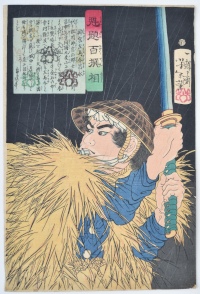
Click here to view image full size.
The warrior Jingu Samanosuke Masanaga holding a sword and wearing a mino (straw cape) in heavy rain. From a set Kaidai hyaku, “Yoshitoshi’s Selection of One Hundred Warriors.” Sixty-five prints published by Ohashiya Yashichi between 1868 and 1869, this being 1869. The text in the square cartouches in this set refer to prominent warriors in the internecine wars of the 16th century but in fact the subjects are Shogitai soldiers. (Those that held out against the imperial forces and were massacred at Ueno, 4/7/1868.) An excellent set.
Fine impression and colour. The rain printed in silver. Fine condition. Signed Ikkaisai Yoshitoshi htsu.
Status: Sold
Tsukioka YOSHITOSHI (1839-1892)

Click here to view image full size.
A design from the set Azuma no nishiki ukiyo kodan, “Tales of the Floating World on Eastern Brocade.” Kodan (traditional storytelling) raconteurs narrated Japanese folk stories, sometimes accompanying themselves with wooden blocks clapped together or a fan giving rhythm. The Kodan text is shown above. Having been popular from around 1700 (and known as Koshaku), these performances gained renewed popularity in the 1850s with the classic standards augmented by contemporary stories of heroes and villains. Here, the wounded and blood-smeared chief of the Edo otokodate, Banzuin Chobei, is seen drinking water in a bathhouse where he is treacherously murdered by Mizuno Jurozaemon. Various publishers from 1867-68, here Sekiguchi Gyokumeido, 10/1867.
Fine impression. Very good colour. Slight trimming, otherwise very good condtion. Signed Ikkaisai Yoshitoshi hitsu.
Status: Sold
Tsukioka YOSHITOSHI (1839-1892)

Click here to view image full size.
A design from the set Azuma no nishiki ukiyo kodan, “Tales of the Floating World on Eastern Brocade.” Kodan (traditional storytelling) raconteurs narrated Japanese folk stories, sometimes accompanying themselves with wooden blocks clapped together or a fan giving rhythm. The Kodan text is shown above. Having been popular from around 1700 (and known as Koshaku), these performances gained renewed popularity in the 1850s with the classic standards augmented by contemporary stories of heroes and villains. Shows Mukokizu Yosa stabbing Komori Yasu (Yasu the Bat); so-called because of the bat-like birthmark on his cheek. A gruesome scene with Yasu covered in blood. Various publishers from 1867-68, here Omiya Kyojiro, 11/1867.
Fine impression. Very good colour. Slight trimming, otherwise very good condtion. Signed Ikkaisai Yoshitoshi hitsu.
Status: Sold
Tsukioka YOSHITOSHI (1839-1892)

Click here to view image full size.
A design from the set Azuma no nishiki ukiyo kodan, “Tales of the Floating World on Eastern Brocade.” Kodan (traditional storytelling) raconteurs narrated Japanese folk stories, sometimes accompanying themselves with wooden blocks clapped together or a fan giving rhythm. The Kodan text is shown above. Having been popular from around 1700 (and known as Koshaku), these performances gained renewed popularity in the 1850s with the classic standards augmented by contemporary stories of heroes and villains. Shows Lady Masao from Osasahara surrounded by curling snakes who force her to reveal her true identity – the Fox Spirit. Various publishers from 1867-68, here Omiya Kyojiro, 11/1867.
Fine impression. Very good colour. Slight trimming, otherwise very good condtion. Signed Ikkaisai Yoshitoshi hitsu.
Status: Sold
Tsukioka YOSHITOSHI (1839-1892)

Click here to view image full size.
A design from the set Azuma no nishiki ukiyo kodan, “Tales of the Floating World on Eastern Brocade.” Kodan (traditional storytelling) raconteurs narrated Japanese folk stories, sometimes accompanying themselves with wooden blocks clapped together or a fan giving rhythm. The Kodan text is shown above. Having been popular from around 1700 (and known as Koshaku), these performances gained renewed popularity in the 1850s with the classic standards augmented by contemporary stories of heroes and villains. Shows Azekura Jushiro slashing Hinotama no Sangoro who is covered in blood. Various publishers from 1867-68, here Sanoya Tomigoro, 9/1867.
Fine impression. Very good colour. Slight trimming, otherwise very good condtion.
Status: Sold
Tsukioka YOSHITOSHI (1839-1892)
Click here to view image full size.
One volume Shuzo suiko meimei den, Shohen, “ Portraits of the Characters in the Suikoden, First Series.” Original embossed orange covers with yellow title slip. Inside front cover title and signature within a western-style surround. Preface 6 pp. including two double-page colour illustrations, last sheet dated Keio 3 ( 1867 ). And 18 numbered pages with 36 illustrations of Suikoden warriors on yellow grounds. Inside back cover advertisements. Published by Odawaraya Yashichi, Edo. In extremely good condition. Superb engraving ( by Egawa Ichigoro ). Presumably a response to the copper plate books and prints being circulated at the time. There is a two volume variant of this book printed in just sumi and blue. However, judging from the impressions in this one volume version with woodgrain showing and blind printing, this must be a very early printing.
Status: Sold
Tsukioka YOSHITOSHI (1839-1892)
Click here to view image full size.
An original painting showing what is probably the most famous encounter in Japanese mythology: The scene is evening on Gojo Bridge in Kyoto where the twenty year old Benkei ambushes samurai to steal their swords. He is shown approaching the flute-playing Yoshitsune. A fight ensues which Yoshitsune wins due to his leaping ability taught to him by the mountain tengu. Yoshitsune pardons Benkei and they become loyal friends. This painting, in shades of sumi, beautifully evokes the crepuscular gloom. On silk, 7 x 9.5 in; 17.75 x 24.1 cms. Painted c late 1870s. Signed Yoshitoshi with Taiso seal.
Status: Sold
Tsukioka YOSHITOSHI (1839-1892)
Click here to view image full size.
A vertical diptych showing Cho Jun, the white stripe in the waves, wrestling in the river with Ri Ki, the black whirlwind. Ronhakucho Chojun kokusempu Riki kochu ni tatakau no zu. The story concerns the river pirate, Ri Ki, who is caught stealing fish by Cho Jun and the ensuing underwater battle. Initially, Ri Ki has the upper hand but Cho Jun challenges him again and they fight until Ri Ki’s compatriots stop the engagement and invite Cho Jun to join their gang. Published by Matsui Eikichi, 1887. This is the extremely rare first state before the publisher and date in left margin. See my blog.
Very fine impression. Fine colour. Slight discolouration to top margins, otherwise fine condition. Full margins all round with ample room for joining. Signed Oju Yoshitoshi hitsu.
Status: Sold
Tsukioka YOSHITOSHI (1839-1892)
Click here to view image full size.
The best design from the set Tsuki hyakushi, the “Hundred Phases of the Moon”. The set published between 1885 and 1892 ( this being 1886 ) by Akiyama Buemon. Benkei against a full moon. In 1185 Yoshitsune attacked by his half-brother Minamoto no Yoritomo, was forced to flee to northern Japan by ship. Sailing along the Inland Sea off the coast of Harima Province not far from Kyoto, the ship was struck by a storm in Daimotsu Bay caused by the vengeful ghosts of the Taira warriors Yoshitsune and his men had slain. Benkei pacified the spirits in the prow of the boat by holding up his string of prayer beads.
Fine impression, colour and condition. (A good guide to the quality of the impression is to look at the outline of Benkei’s face: This fine line started to break down early on.) An impression that has not been in an album: Full margins with very extensive mica. Signed Yoshitoshi.
Status: Sold
Tsukioka YOSHITOSHI ( 1839-1892 )
Click here to view image full size.
An original painting showing Fukurokugu – the God of Happiness, Wealth and Longevity and one of the Seven Gods of Good Luck, Shichi-fuku-ji, teasing a cat with the tassle on his fan. The Seven Gods theme comes from China, and possibly India as well, apart from Ebisu. Sumi on paper. Light creasing and rubbing at top otherwise good condition. Image size 47.75 x 22.5 in; 121.5 x 57 cms. Painted c 1880s.
Signed Yoshitoshi with seals Taiso Yoshitoshi.
Status: Sold
Tsukioka YOSHITOSHI (1839-1892 )
Click here to view image full size.
Taira no Masakado ( 901-940 ) from an extremely rare and early set: Honcho hyaku yuden, “One Hundred Warriors of Japan.” Masakado was an interloper who attempted to set up a rival court at Ishii in Shimosa to that of Regent Tadahira in Kyoto. He was subsequently killed by Hidesato on the orders of the Regent. Masakado was guarded by a number of ghostly doubles who impersonated him making killing him difficult. These ghostly doppelgangers are seen here in the background. Published 1862 by Enshu-ya Hikobei although it is not known how many prints there are in the set and Keys ( Courage and Silence, Yoshitoshi, 1982 ) only knew of the set from the Netto list.
Very fine impression. Fine colour and condition. Signed Ikkaisai Yoshitoshi hitsu.
Status: Sold
Tsukioka YOSHITOSHI ( 1839-1892 )
Click here to view image full size.
Arguably Yoshitoshi’s masterpiece in the triptych format. Shows Mongaku ( Endo Morito, c.1120-1200 ) subjecting himself to three year’s penance as a Buddhist monk beneath the waterfall of Mount Nachi in Kii Province. Morito inflicted this punishment on himself because he had inadvertently cut off the head of Kesa Gozen, the wife of the palace guard Watanabe Wataru, with whom he was in love. Published 1859 ( centre sheet ) and 1860 ( outside panels ) by Kadokin. Extremely rare: Another impression in the Baur collection, Geneve, Switzerland.
Fine impression, very good colour. Minor soil bottom left corners of last two sheets, otherwise very good condition. Extensive splashed gofun. Signed Ikkaisai Yoshitoshi hitsu.
Status: Sold
Tsukioka YOSHITOSHI (1839-1892)
Click here to view image full size.
Shows the crucifiction of Torii Tsuneemon Katsutaka. The finest design from Kaidai hyaku senso, “Yoshitoshi’s Selection of One Hundred Warriors.” The set depicts warriors from the sixteenth century although based on Yoshitoshi’s record of the battle of Ueno in 1868. Torii Tsuneemon was a retainer of Okudaira Sadamasa and a member of the Nagashino Castle garrison when it came under siege by Takeda Katsuyori in 1575. He bravely volunteered to sneak through enemy lines to get help. However, he was captured on his return and ordered to shout to his compatriots that no help was coming. Instead he shouted encouragement and was crucified. Published by Ohashi, 1868.
Fine impression with mica and gum applied to spear. Fine colour. Slight soil at bottom, otherwise very good condition. Signed Ikkaisai Yoshitoshi ga.
Status: Sold
Tsukioka YOSHITOSHI (1839-1892)
Click here to view image full size.
Flowers from a set of three triptychs showing half-length portraits of actors based on the Snow, Moon, Flowers theme. Shows the actor Ichikawa Sadanji as Gosho no Gorozo, the main character in the play Soga moyo tateshi no goshozome, “The Story of Gorozo, the Chivalrous Commoner.” A complex story which ends with Gorozo killing his old master’s lover, the courtesan Oshu. Published by Akiyama Buemon, 1890.
Fine impression, colour and condition. Signed Yoshitoshi.
Status: Sold
